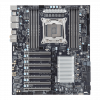Noticed this motherboard today: (Well, yesterday, now...)

Crazy! Also: sooo so beautiful!
I wants... *drools*
Read that intel's newest core i9 series isn't so great for gaming because of smaller, slower L3, but all I can think of is this motherboard, a 10-core CPU slotted into it, and all 8 DIMM sockets shoved full of luscious LED-lit DIMMs, and some RGB LED fans and strips hooked up to this mobo - to quote/paraphrase my favorite mad villain Judge Doom: My god, it will be beautiful!
Did you know there's Aura Sync-compatible power supplies too?! *gulp* And even an SSD! lol
(I can do without LEDs on my SSDs, don't worry... )
)

Crazy! Also: sooo so beautiful!
I wants... *drools*
Read that intel's newest core i9 series isn't so great for gaming because of smaller, slower L3, but all I can think of is this motherboard, a 10-core CPU slotted into it, and all 8 DIMM sockets shoved full of luscious LED-lit DIMMs, and some RGB LED fans and strips hooked up to this mobo - to quote/paraphrase my favorite mad villain Judge Doom: My god, it will be beautiful!
Did you know there's Aura Sync-compatible power supplies too?! *gulp* And even an SSD! lol
(I can do without LEDs on my SSDs, don't worry...



